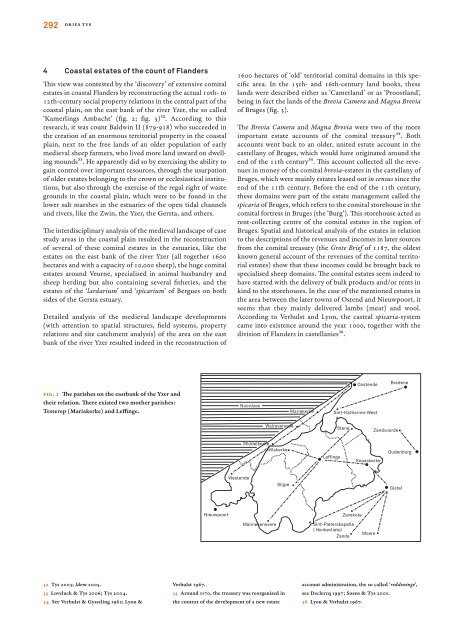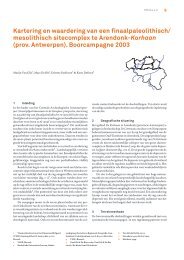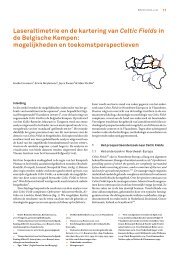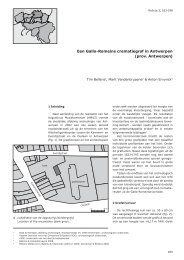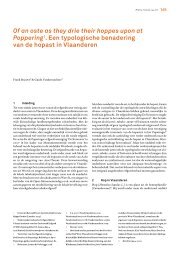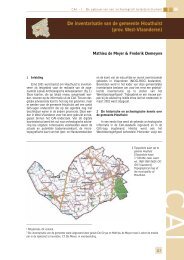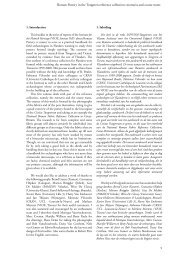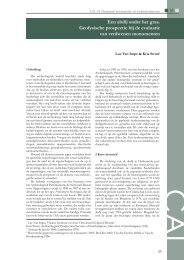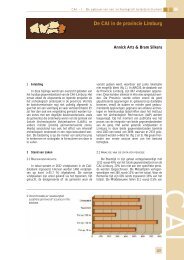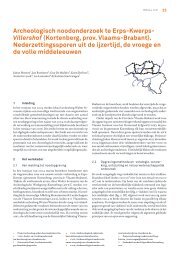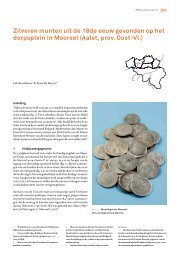Exchanging Medieval Material Culture Studies on archaeology and ...
Exchanging Medieval Material Culture Studies on archaeology and ...
Exchanging Medieval Material Culture Studies on archaeology and ...
Create successful ePaper yourself
Turn your PDF publications into a flip-book with our unique Google optimized e-Paper software.
292<br />
Dries Tys<br />
4 Coastal estates of the count of Fl<strong>and</strong>ers<br />
Th is view was c<strong>on</strong>tested by the ‘discovery’ of extensive comital<br />
estates in coastal Fl<strong>and</strong>ers by rec<strong>on</strong>structing the actual 10th- to<br />
12th-century social property relati<strong>on</strong>s in the central part of the<br />
coastal plain, <strong>on</strong> the east bank of the river Yzer, the so called<br />
‘Kamerlings Ambacht’ (fi g. 2; fi g. 3)32. According to this<br />
research, it was count Baldwin II (879-918) who succeeded in<br />
the creati<strong>on</strong> of an enormous territorial property in the coastal<br />
plain, next to the free l<strong>and</strong>s of an older populati<strong>on</strong> of early<br />
medieval sheep farmers, who lived more l<strong>and</strong> inward <strong>on</strong> dwelling<br />
mounds33. He apparently did so by exercising the ability to<br />
gain c<strong>on</strong>trol over important resources, through the usurpati<strong>on</strong><br />
of older estates bel<strong>on</strong>ging to the crown or ecclesiastical instituti<strong>on</strong>s,<br />
but also through the exercise of the regal right of waste<br />
grounds in the coastal plain, which were to be found in the<br />
lower salt marshes in the estuaries of the open tidal channels<br />
<strong>and</strong> rivers, like the Zwin, the Yzer, the Gersta, <strong>and</strong> others.<br />
Th e interdisciplinary analysis of the medieval l<strong>and</strong>scape of case<br />
study areas in the coastal plain resulted in the rec<strong>on</strong>structi<strong>on</strong><br />
of several of these comital estates in the estuaries, like the<br />
estates <strong>on</strong> the east bank of the river Yzer (all together 1600<br />
hectares <strong>and</strong> with a capacity of 10,000 sheep), the huge comital<br />
estates around Veurne, specialised in animal husb<strong>and</strong>ry <strong>and</strong><br />
sheep herding but also c<strong>on</strong>taining several fi sheries, <strong>and</strong> the<br />
estates of the ‘lardarium’ <strong>and</strong> ‘spicarium’ of Bergues <strong>on</strong> both<br />
sides of the Gersta estuary.<br />
Detailed analysis of the medieval l<strong>and</strong>scape developments<br />
(with attenti<strong>on</strong> to spatial structures, fi eld systems, property<br />
relati<strong>on</strong>s <strong>and</strong> site catchment analysis) of the area <strong>on</strong> the east<br />
bank of the river Yzer resulted indeed in the rec<strong>on</strong>structi<strong>on</strong> of<br />
Fig. 2 Th e parishes <strong>on</strong> the eastbank of the Yzer <strong>and</strong><br />
their relati<strong>on</strong>. Th ere existed two mother parishes:<br />
Testerep (Mariakerke) <strong>and</strong> Leffi nge.<br />
32 Tys 2003; Idem 2005.<br />
33 Loveluck & Tys 2006; Tys 2004.<br />
34 See Verhulst & Gysseling 1962; Ly<strong>on</strong> &<br />
Verhulst 1967.<br />
Nieuwpoort<br />
35 Around 1170, the treasury was reorganised in<br />
the c<strong>on</strong>text of the development of a new estate<br />
1600 hectares of ‘old’ territorial comital domains in this specifi<br />
c area. In the 15th- <strong>and</strong> 16th-century l<strong>and</strong> books, these<br />
l<strong>and</strong>s were described either as ‘Camerl<strong>and</strong>’ or as ‘Proostl<strong>and</strong>’,<br />
being in fact the l<strong>and</strong>s of the Brevia Camera <strong>and</strong> Magna Brevia<br />
of Bruges (fi g. 3).<br />
Th e Brevia Camera <strong>and</strong> Magna Brevia were two of the more<br />
important estate accounts of the comital treasury34. Both<br />
accounts went back to an older, united estate account in the<br />
castellany of Bruges, which would have originated around the<br />
end of the 11th century35. Th is account collected all the revenues<br />
in m<strong>on</strong>ey of the comital brevia-estates in the castellany of<br />
Bruges, which were mainly estates leased out in census since the<br />
end of the 11th century. Before the end of the 11th century,<br />
these domains were part of the estate management called the<br />
spicaria of Bruges, which refers to the comital storehouse in the<br />
comital fortress in Bruges (the ‘Burg’). Th is storehouse acted as<br />
rent-collecting centre of the comital estates in the regi<strong>on</strong> of<br />
Bruges. Spatial <strong>and</strong> historical analysis of the estates in relati<strong>on</strong><br />
to the descripti<strong>on</strong>s of the revenues <strong>and</strong> incomes in later sources<br />
from the comital treasury (the Grote Brief of 1187, the oldest<br />
known general account of the revenues of the comital territorial<br />
estates) show that these incomes could be brought back to<br />
specialised sheep domains. Th e comital estates seem indeed to<br />
have started with the delivery of bulk products <strong>and</strong>/or rents in<br />
kind to the storehouses. In the case of the menti<strong>on</strong>ed estates in<br />
the area between the later towns of Ostend <strong>and</strong> Nieuwpoort, it<br />
seems that they mainly delivered lambs (meat) <strong>and</strong> wool.<br />
According to Verhulst <strong>and</strong> Ly<strong>on</strong>, the castral spicaria-system<br />
came into existence around the year 1000, together with the<br />
divisi<strong>on</strong> of Fl<strong>and</strong>ers in castellanies36.<br />
Westende<br />
Noordzee<br />
Walraversyde<br />
Middelkerke<br />
Wilskerke<br />
Slijpe<br />
Mariakerke<br />
Leffinge<br />
Oostende<br />
Sint-Katharina-West<br />
Stene<br />
Zevekote<br />
Mannekensvere Sint-Pieterskapelle<br />
( H<strong>on</strong>kevliete)<br />
Z<strong>and</strong>e<br />
Snaaskerke<br />
Moere<br />
Z<strong>and</strong>voorde<br />
Bredene<br />
Oudenburg<br />
Gistel<br />
account administrati<strong>on</strong>, the so called ‘reddeninge’,<br />
see Declercq 1997; Soens & Tys 2001.<br />
36 Ly<strong>on</strong> & Verhulst 1967.


